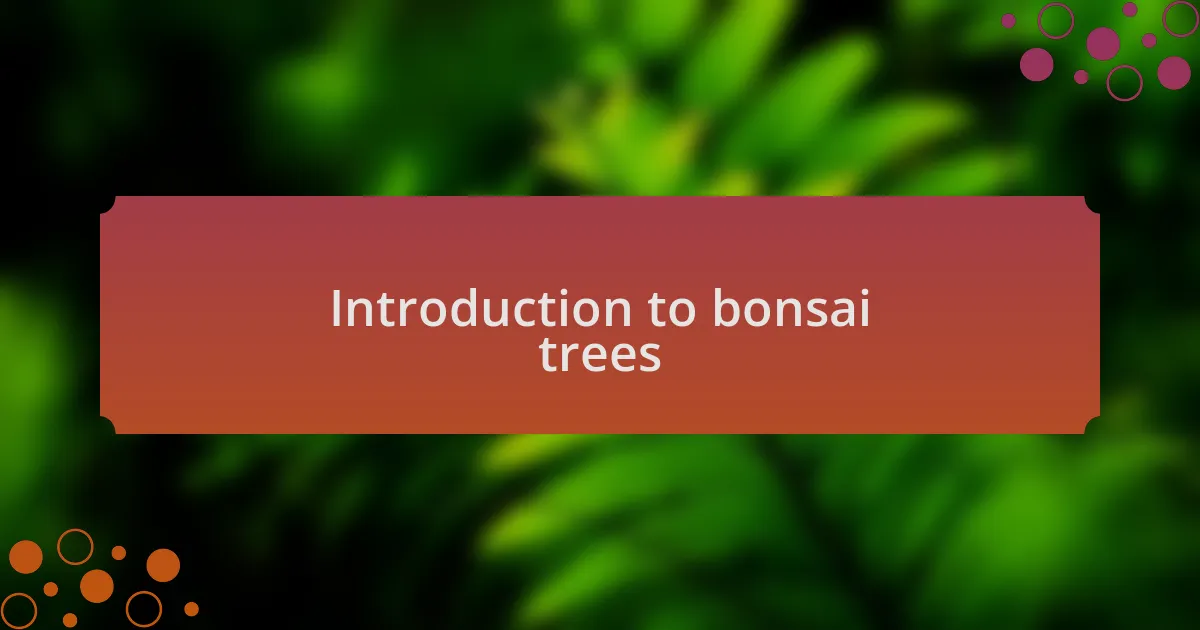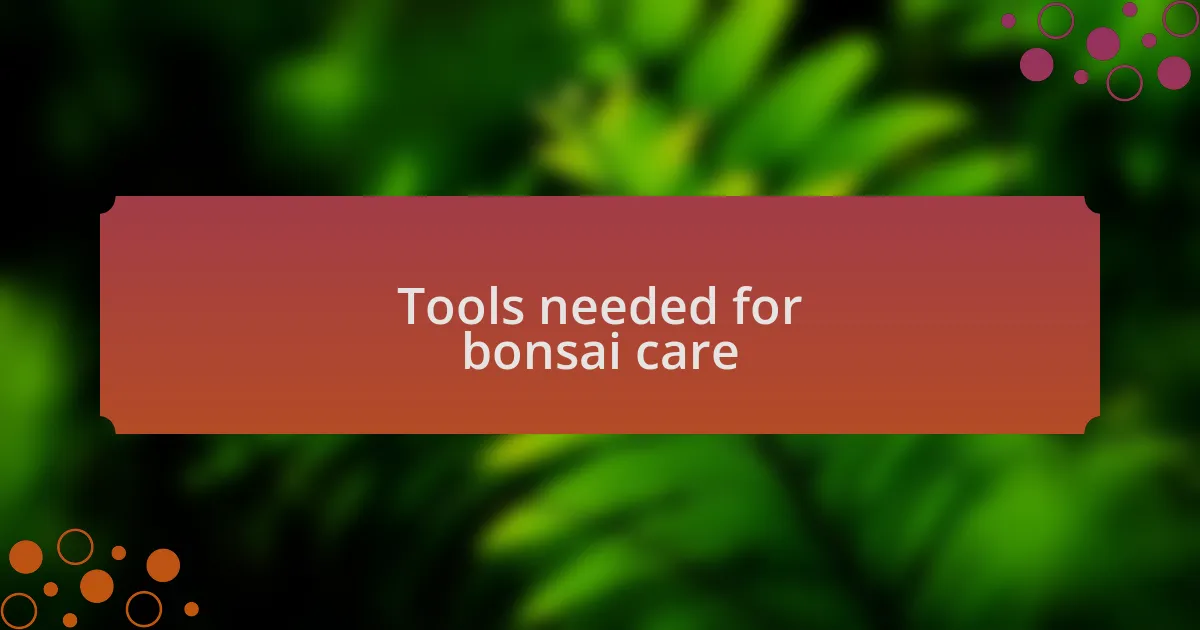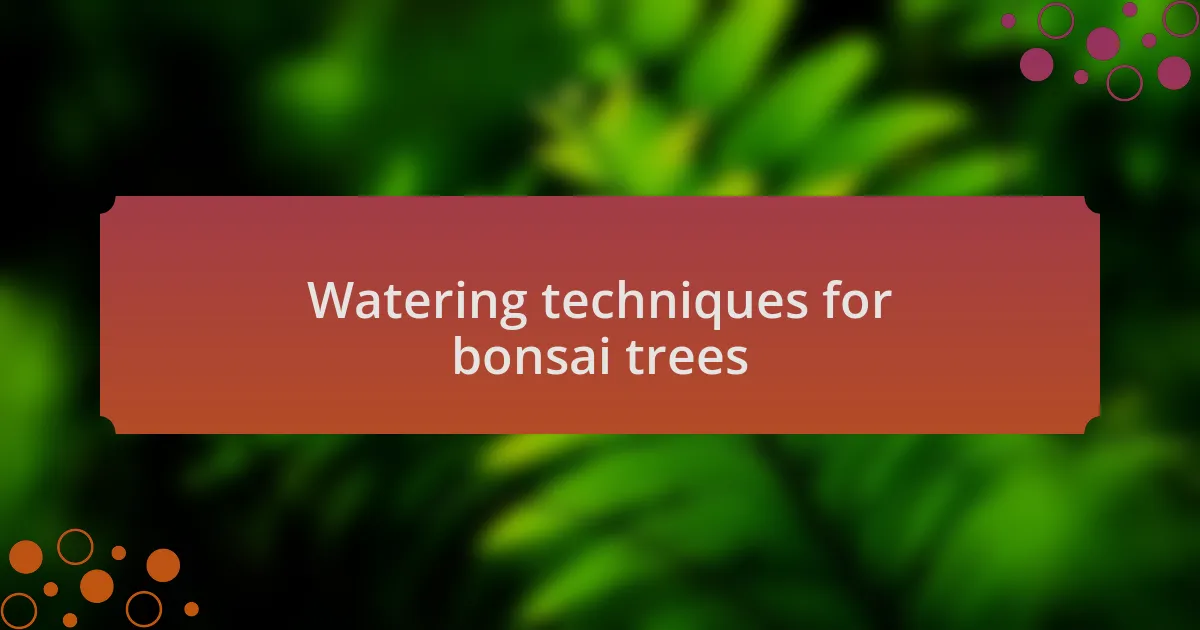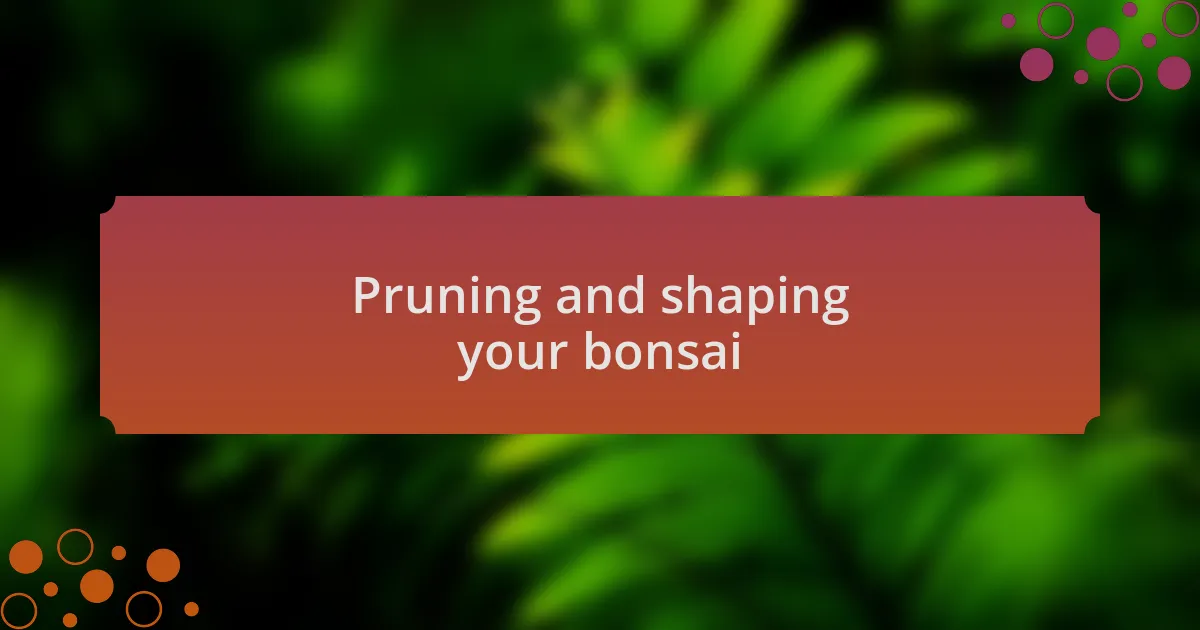Key takeaways:
- Bonsai trees symbolize a connection to nature and personal growth, requiring patience and artistry in their care.
- Using the right tools, such as concave cutters and quality bonsai soil, is crucial for successful bonsai cultivation.
- Watering techniques vary by species and environment; methods like soak-and-drain can promote better hydration for roots.
- Pruning and shaping reflect the essence of the tree, with timing being key to ensure healthy growth after intervention.

Introduction to bonsai trees
Bonsai trees hold a unique place in my heart. When I first encountered one in a tranquil courtyard, I marveled at how such a small tree could embody years of nurturing and artistry. Each bonsai tells a story about where it has been and the meticulous care it has received — it’s almost like a living journal of its owner’s journey in cultivating patience and skill.
These miniature trees are not just about aesthetics; they represent a philosophy of harmony with nature. I remember my first attempt at shaping a bonsai — the quiet focus required to prune and style it was both challenging and deeply rewarding. Have you ever experienced that sense of connection with a plant that makes time feel suspended? That’s the magic of bonsai.
Historically, bonsai has roots that trace back over a thousand years, originating in China before finding its way to Japan. This rich heritage adds another layer of appreciation for these tiny trees. As I’ve learned more about their cultivation techniques, I can’t help but feel an admiration for the dedication that bonsai artists pour into their craft—it’s about much more than just growing a tree; it’s about growing yourself alongside it.

Tools needed for bonsai care
When it comes to caring for bonsai trees, having the right tools can make all the difference. I remember my early days of bonsai cultivation — I started with a basic pair of pruning scissors, and while they did the job, I quickly realized that specialized tools like concave cutters and wire cutters truly elevate the experience. Each tool serves a specific purpose; for instance, concave cutters help create clean cuts that heal nicely, while the wire cutters allow for precise shaping without damaging delicate branches.
One item I can’t stress enough is high-quality bonsai soil. Its composition is crucial for drainage and moisture retention. In my experience, using a blend that includes akadama, pumice, and lava rock provides a balanced environment for roots to thrive. Have you ever felt the joy of watching new growth emerge after paying attention to the soil quality? It’s incredibly fulfilling to witness your efforts rewarded in such a tangible way.
Lastly, don’t overlook the value of a watering can with a fine spout. It might seem like a small detail, but I find that it allows for gentle watering, preventing disturbances to the soil. I’ve learned the hard way that overwatering can lead to root rot, so having this tool really helps in maintaining just the right amount of moisture. Choosing the right tools not only supports the health of your bonsai but also enriches the overall experience of caring for such a magnificent art form.

Watering techniques for bonsai trees
Watering bonsai trees requires careful attention, and I’ve learned that there’s no one-size-fits-all approach. I recall the anxious days when I overwatered my first tree, thinking it would benefit from extra hydration. Instead, I saw leaves turn yellow and fall off—an early lesson in knowing when to stop. Understanding your bonsai’s specific needs based on its species, size, and environment is vital in determining how much water it truly requires.
Timing your watering can make a significant difference too. I’ve noticed that bonsai thrive when watered in the early morning or late afternoon when temperatures are cooler. This strategy allows the moisture to seep deep into the soil, giving the roots time to absorb the water before the heat of the day begins. Have you ever touched the soil and felt it dry just a bit too quickly? That sensation often signals it’s time for some water, but I always recommend checking the soil moisture a couple of inches down to avoid giving my trees a quick drink when they don’t need it.
Lastly, techniques like the soak-and-drain method have become my go-to practice. By placing the pot in a basin of water and allowing it to absorb moisture from the bottom, I’ve found the results astonishing. Watching the soil darken as it absorbs water fills me with anticipation; it’s like seeing my tree sip happily. The best part? This method helps ensure that the entire root system receives hydration, fostering healthier growth over time.

Pruning and shaping your bonsai
Pruning and shaping bonsai trees is where the true artistry of bonsai cultivation reveals itself. I often find myself standing in front of my trees, scissors in hand, contemplating each cut’s impact on their growth. It can feel a bit intimidating at first, but as I learned, it’s all about understanding the tree’s natural growth patterns. Have you ever considered how a simple snip can steer the entire trajectory of your bonsai’s beauty?
When shaping, I always focus on creating a balanced silhouette that captures the essence of the tree’s species. I recall my first attempt at styling a juniper; I was nervous but excited. After carefully removing branches that crowded the center, I was amazed by how light and space transformed its appearance. This moment taught me that good pruning isn’t just functional—it reveals the soul of the bonsai.
Timing remains crucial in this delicate process. I’ve found that late winter or early spring is the perfect window for pruning, just before the growing season begins. This timing ensures that the tree is ready to heal and flourish after I reshape it. Reflecting on my experiences, it’s clear that patience plays a significant role—watching the tree react to my decisions is a gratifying journey that connects me deeper to nature.

Personal experiences with bonsai care
Caring for bonsai trees has been a journey filled with unexpected lessons. I remember my first watering experience, when I mistakenly over-watered my little Ficus. Watching those leaves droop was a gut-wrenching moment. It taught me an invaluable lesson about balance; now I always check the soil moisture before reaching for the watering can. Have you ever had a similar realization in your own plant care journey?
Fertilizing my bonsai is another area where I’ve learned through trial and error. Early on, I was too eager and overloaded my Pine with fertilizers, thinking it would grow faster. Instead, it became stunted and discolored. That misstep reminded me that bonsai care isn’t about hurrying the process but nurturing it patiently. Sometimes, less truly is more in our quest for growth, don’t you agree?
As seasons change, so does my approach to bonsai care. I’ve realized that each season offers unique challenges and opportunities. For instance, during fall, I cherish the moment when I can adjust my trees for winter’s rest. I always spend extra time observing their habits and preparing them for the colder months. There’s a certain magic in this cyclical care that makes me feel deeply connected to the earth’s rhythms. Seeing my trees thrive through this process is a rewarding affirmation of my efforts.